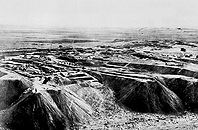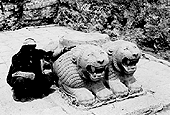Tell Ta'yinat

Tell Ta'yinat, nearby Tell Atchana (historical Alalakh) is one of the largest sites in the Amuq Valley. It was excavated by the Oriental Institute's Amuq expedition from 1935 to 1938. They uncovered a complex of monumental buildings at the summit of the mound which date to the Iron Age (800-500 BC). At that time, Tell Ta'yinat was the capital of a Neo-Hittite kingdom centered in the Amuq Plain. The Assyrian kings Asurnasirpal II and Sennacarib III record campaigns to the Amuq, refering to it as the "kingdom of Hattina" and later the "kingdom of Unqi". Excavations at the site produced several large stone sculpures and stela, which are now in the Antakya Museum. Deeper levels at Ta'yinat demonstrate that the site was also occupied during the Early Bronze Age (third millennium BC), but exposures of this earlier phase were very limited.
 Unfortunately, Tell Ta'yinat is one of many sites in the Amuq which has been damaged recently by both earth moving activites and agriculture. In addition to intensive cotton farming on the mound itself, a large cotton processing facility has been built on the summit of the site, obscuring some of the earlier excavations. In 1999, the Amuq Third Millennium Survey team returned to Tell Ta'yinat and collected surface materials. The team also rediscovered some architectural remains originally excavated in the 1930's, allowing the old plans of the site to be correlated with the modern cultivated mound, and providing a basis for gauging damage to the archaeological remains.
Unfortunately, Tell Ta'yinat is one of many sites in the Amuq which has been damaged recently by both earth moving activites and agriculture. In addition to intensive cotton farming on the mound itself, a large cotton processing facility has been built on the summit of the site, obscuring some of the earlier excavations. In 1999, the Amuq Third Millennium Survey team returned to Tell Ta'yinat and collected surface materials. The team also rediscovered some architectural remains originally excavated in the 1930's, allowing the old plans of the site to be correlated with the modern cultivated mound, and providing a basis for gauging damage to the archaeological remains.

